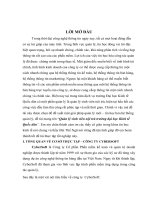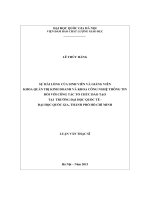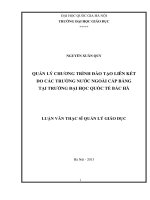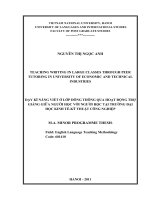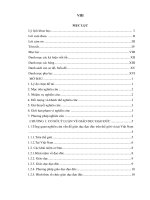Health and nature of K-Food combining flavor - Trường Đại Học Quốc Tế Hồng Bàng
Bạn đang xem bản rút gọn của tài liệu. Xem và tải ngay bản đầy đủ của tài liệu tại đây (2.5 MB, 20 trang )
<span class='text_page_counter'>(1)</span><div class='page_container' data-page=1>
<b>About the series</b>
The Korean Culture series is one of the Korean
Culture and Information Service’s projects to
furnish international readers with insights into and
basic understanding of the dynamic and diverse
aspects of contemporary Korean culture.
food
Co
m
bi
ni
ng F
la
vo
r, H
ea
lth
, an
d N
atu
re
The Korean Culture and Information Service
(KOCIS) was inaugurated as the Overseas
Information Center under the Ministry of
Culture and Information in 1971. Its aim is
to introduce Korean culture to the world and
to raise Korea’s national profile. KOCIS has
worked to consolidate ties with countries all
over the world through cultural exchange.
It continues working today to explore new
ways of bringing Korean art and culture to the
citizens of the world.
About
<b>Combining Flavor, Health, and Nature</b>
FOOD
K
Korean Culture and
Information Service
</div>
<span class='text_page_counter'>(2)</span><div class='page_container' data-page=2>
FOOD
</div>
<span class='text_page_counter'>(3)</span><div class='page_container' data-page=3>
K-Food
:
<b> Combining Flavor, Health, and Nature</b>Copyright © 2013
by Korean Culture and Information Service
All Rights Reserved.
No part of this book may be reproduced or utilized in any form or by any means
without the written permission of the publisher.
First Published in 2013 by
Korean Culture and Information Service
Ministry of Culture, Sports and Tourism
Phone: 82-2-398-1914~20
Fax: 82-2-398-1882
Website: www.kocis.go.kr
ISBN: 978-89-7375-579-0 04590
ISBN: 978-89-7375-578-3 04080 (set)
Printed in the Republic of Korea
For further information about Korea, please visit:
www.korea.net
<b>Korean Culture No.9</b>
</div>
<span class='text_page_counter'>(4)</span><div class='page_container' data-page=4>
<b>K-Food:</b> Combining Flavor, Health, and Nature
iv K-Food in the World v
<b>Prologue</b>
Chapter One
<b>K-Food in the World</b>
K-Food: A New Global Food Trend
Non-Koreans Share Korean Cuisine with the World
Chapter Two
<b>K-Food, a Harmony of Taste, Health, and Nature</b>
Nutritional Balance in the Korean Diet
Nutritional Value and Health Benefits of Korean Ingredients
Leading Ingredients, Seasonings, and Cooking Techniques
COntents
Chapter Three
<b>The Most Popular K-Foods</b>
Kimchi
Bibimbap: Mixed Rice with Meat and Assorted Vegetables
Bulgogi: Marinated Meat Cooked on the Grill
Bossam: Napa Wraps with Pork
Japchae: Stir-fried Glass Noodles and Vegetables
Haemul Pajeon: Seafood and Green Onion Pancake
Makgeolli: Korean Traditional Rice Wine
Chapter Four
<b>Star Korean Chefs and Their K-Food Creations</b>
<b>Epilogue</b>
<b>Appendix </b>
09
13
13
28
41
41
60
72
83
83
88
92
95
98
101
104
109
110
113
116
118
121
Hooni Kim, Owner-chef of New York's Danji,
the First Korean Restaurant to Earn a Michelin Star
Sang-hoon Degeimbre, Michelin Two-Star Chef at
L’Air du Temps, Combines Artistry with Science
Kim Sohyi of Vienna’s Kim Kocht Brings Gochujang and
Chopsticks to Austria and Germany
David Chang of Momofuku, a Michelin Two-Star Chef Selected
by TIME as One of the World’s 100 Most Influential People
Yim Jungsik, Michelin Two-Star Chef at Jungsik, Captivates
New Yorkers with Fusion Korean Cuisine
</div>
<span class='text_page_counter'>(5)</span><div class='page_container' data-page=5>
<b>K-Food:</b> Combining Flavor, Health, and Nature
vi K-Food in the World vii
<i>“The noted Chicago eatery Blackbird has kimchi on the menu, and </i>
<i>California Pizza Kitchen is developing Korean barbecue beef pizza. In </i>
<i>Los Angeles, crowds are lining up for street food from a pair of Korean </i>
<i>taco trucks called Kogi. ... Redolent with garlic, sesame oil and red chili </i>
<i>peppers, Korean food is suddenly everywhere.”</i>
Juliet Chung, <i>Wall Street Journal</i>, March 7, 2009
<i>“There is no shortage of top-quality Korean ingredients – fish, </i>
<i>shellfish, marbled beef – and there is great affection for kimchi, a </i>
<i>condiment of fermented cabbage, radishes, chilli, fish sauce, garlic, </i>
<i>and ginger. … Korean food—spicy, quickly prepared and served—also </i>
<i>lends itself to the informal style of restaurant that has seen Wagamama, </i>
<i>Busaba Eathai, and Ping Pong in London, as well as Momofoku in New </i>
<i>York, achieve such success.”</i>
Nicholas Lander, <i>Financial Times</i>, January 21, 2011
<i>“Salt Lake City’s food scene is in for a healthy jolt. Korean food is a </i>
<i>hot ethnic dining trend on the west and east coasts and is seeping into </i>
<i>mainstream restaurants in Utah.”</i>
</div>
<span class='text_page_counter'>(6)</span><div class='page_container' data-page=6>
<b>K-Food:</b> Combining Flavor, Health, and Nature
viii Prologue 9
<b>Prologue</b>
A wide variety of plates and bowls are used to set a table with<i> hansik, </i>
or Korean food<i>. Bap </i>(cooked rice), and a bowl of soup made from either
meat and vegetables or fish, are set in front of the diner. A large pot or
bowl of stew is placed at the center of the table, while various <i>banchan</i>
(side dishes) are neatly arranged on the table. All of these dishes are set
together, and the harmony created by the vegetable dishes and meat
dishes seasoned with fermented sauces which have been made over a
long period of time with care, is what makes <i>hansik </i>uniquely Korean.
Despite this uniqueness and the variety of food that is offered, the only
Korean foods that were familiar to non-Koreans were the simple <i>bulgogi </i>
</div>
<span class='text_page_counter'>(7)</span><div class='page_container' data-page=7>
<b>K-Food:</b> Combining Flavor, Health, and Nature
10 Prologue 11
and delicious. World-renowned chefs have also been mesmerized by the
kimchi-making process, with its generous amount of garlic, and have gone
away to create their own style of Korean cuisine. Hallyu (Korean Wave),
with an increasing interest in music and entertainment through K-Pop and
K-Drama, also gave a boost in promoting Korean food.
Non-Koreans who have tasted Korean food say that it has “a unique
flavor and depth” that they cannot describe. This is becauseit is centered
around fermented foods that are carefully and patiently made over time.
These include the sauces, which are infused in the dishes and cleverly
hidden from view, or can be plainly visible delights, such as kimchi and
<i>jangajji </i>(pickled vegetables), <i>doenjang jjigae </i>(soybean paste stew) or
<i>makgeolli</i> (Korean traditional rice wine). These fermented foods are unique
to Korean cuisine, and an essential part of any Korean dish is the Korean
seasoning (the various sauces made from ingredients such as <i>ganjang </i>(soy
sauce), <i>gochu </i>(red chili) flakes, sesame oil, wild sesame oil, minced garlic,
finely chopped green onions, and ginger.)
Korea has four distinct seasons, spring, summer, autumn and winter
and Korean foodreflects what each season has to offer. Each of the dishes
is infused with the colors, smells, textures and flavors of the season,
and reflects the wisdom of the people who discovered these tastes. The
abundance seasonal ingredients allows for a seemingly endless variety
of dishes to be made, and of these, various <i>namul</i> (seasoned vegetable)
dishes, which were blanched or combined with natural oils, made for a
very healthy meal. Korean food also contains healing properties, as it
was believed that “the roots of food and medicine are the same.” Food
could and was used to heal not just the body but the mind as well, so it
only naturally followed that the ingredients used to make dishes were
extremely important, and the food was prepared with great care. Balance
was key in Korean food, and people continually sought to find ingredients
that could work together in perfect harmony in order to be beneficial for
human health.
This book is not only for people who love Korean cuisine, but for anyone
who is even slightly interested in the dishes with the intriguing tastes and
smells “that they call Korean food.”
One has to question whether there is anything that can represent a
country’s culture better than its food. On this note, I hope this book acts
as a friendly guide, and allows you to familiarize yourself with the healthy
and natural food of Korea. I also hope that the book entertains all your
senses, allowing you to imagine and taste Korean food through the history
and stories behind it.
</div>
<span class='text_page_counter'>(8)</span><div class='page_container' data-page=8>
K-Food in the World 13
<b>K-Food</b>
IN THE WORLD
<b>Chapter one</b>
<b>K-Food: A New Global Food Trend</b>
With the presence of Korean communities in a wide variety of countries,
<i>hansik </i>(Korean food) has been making its way across international borders
for many years. The people in these countries have probably even sampled
Korean food while not knowing what kind of food they were really eating.
Up until recently, they might have accepted Korean food to be a strange,
exotic cuisine that only Koreans consume.
However, enter the 1990s and this began to change. People started to
recognize that the unusual food that they had once tasted was Korean.
This awakening was due to people becoming accustomed to Korean
culture, from burning midnight oil with K-Drama, an enthusiastic interest
in K-Pop, and the popularity of Korean-made smartphones. Altogether,
this marked a new surge in interest in Korean Food. No longer was it just
something different to try, but a cuisine that most people were becoming
familiar with.
The sea urchin dish (Korean seaweed rice with crispy quinoa) at Jungsik (Michelin two-star Korean restaurant) in New York
</div>
<span class='text_page_counter'>(9)</span><div class='page_container' data-page=9>
<b>K-Food:</b> Combining Flavor, Health, and Nature
14
of as a blended menu of Korean foodand flexitarianism. He saw amazing
improvements in his body weight and blood sugar levels through this
change in diet (<i>NYT</i>, 2013.4.23). He mentioned eating, at least two or
three times a week, a chopped salad of salted vegetables (while admitting
his uncertainty as to whether the salting technique was Middle Eastern
or Korean). In another column, he suggested <i>juk </i>(Korean porridge) for
breakfast (<i>NYT</i>, 2013.9.17), and elsewhere, he related having gotten
together once with some childhood friends at a Korean restaurant and
persuading them to try <i>galbi</i> (braised short ribs). Even back in the day
when most were unfamiliar with Korean cuisine, Bittman recognized its
outstanding nutritional value and health benefits. In his column “Exploring
the World of Kimchi, the Spicy Korean Staple” (<i>NYT</i>, 1996.4.10), he
By this time, there was increased awareness that the distinctive
characteristic of Korean food was fermented food derived from a
wide range of ingredients and spicy, salty condiments, and that it was
fundamentally healthy. This interest was aided by futurist Alvin Toffler’s
prediction that the third taste to catch the attention of the world food
scene, following salty and spicy, would be that of fermentation.
People in this modern age find it difficult to decide what and how to eat,
and the word flexitarian, nominated as the most useful word in the United
States in 2003, encapsulates this dilemma. In practice, food experts in the
Western world proactively turned to, and publicized, Korean food. Western
media, too, have printed favorable reports, and people who have tried it
praise it for its taste and health benefits.
Prominent food columnist Mark Bittman, whose <i>Minimalist</i> series ran
in <i>The New York Times</i> (<i>NYT</i>) for more than 13 years, went on a
meat-restricted, largely plant-based diet, or what can otherwise be conceived
Korean fermented seasonings (clockwise from top left):
<i>ganjang</i> (soy sauce), <i>jeotgal</i> (salted seafood), <i>doenjang</i> (soybean paste)
</div>
<span class='text_page_counter'>(10)</span><div class='page_container' data-page=10>
<b>K-Food:</b> Combining Flavor, Health, and Nature
16 K-Food in the World 17
described vividly how several American chefs have ventured into kimchi
territory, while also sharing a few of their recipes for this spicy dish and
his own reduced <i>gochu</i> (red chili) flake kimchi recipe, adjusted to suit his
tolerance level. His recent claim to kimchi fandom had him declaring that,
“kimchi is a remarkable dish. Super-high flavor, no fat, and lots of varieties
that go with almost everything.” I can understand why people eat kimchi
daily,” in an interview with a Korean paper (<i>JoongAng Daily</i>, 2009.2.1).
While promoting this meat-restricted, plant-based diet to his readers, he
added that for quite some time, he had often had Korean dishes, and even
tried his hand at preparing them.
<i>The Wall Street Journal </i>(2009.3.7) ran an article that reported how, for
many years, Korean food remained in traditional restaurants in areas
where most Korean immigrants settled, such as in Hawaii or Los Angeles.
In recent years though, the symbolic Korean flavors of pungent garlic,
sesame oil, and spicy <i>gochu</i> (Korean chili) can be found everywhere.
Leading the pack are <i>bulgogi</i> (marinated meat cooked on the grill) and
kimchi. California Pizza Kitchen, a leading American pizza chain with
around 250 branches, launched the Korean BBQ Pizza as a seasonal
menu item in April 2013. This pizza, which featured the Korean toppings of
<i>bulgogi</i> and kimchi salad, was well-received. The Bulgogi Burger at Burger
Tex is another crowd favorite. On the restaurant front, items like kimchi
pasta and kimchi with lobster are debuting on menus.
In Los Angeles, there is the specialty served up from Korean chef Roy
Choi’s Korean taco truck Kogi-Korean-BBQ-TO-GO, the kimchi taco for $2
a pop. With its frequent SNS updates on its whereabouts, Kogi is a big
hit. According to news outlets like the <i>New York Times</i>, <i>Newsweek</i>, and
the BBC, hundreds of people form queues at the truck, and a whiff of this
street-food-selling truck hitting New York’s Midtown soon after L.A. kept
International star chef David Chang has been creating new flavors by blending traditional Korean cooking
methods with various Western culinary techniques. One of his dishes making waves in New York is this<i> bossam</i>
(napa wraps with pork).
</div>
<span class='text_page_counter'>(11)</span><div class='page_container' data-page=11>
<b>K-Food:</b> Combining Flavor, Health, and Nature
18 K-Food in the World 19
its popularity strong.
The current “it” dish on the New York restaurant scene might just be
<i>bossam</i> (napa wraps with pork). Detailing his recipe in the <i>NYT</i> article
“<i>The Bo Ssam Miracle</i>” (2012.1.12), Korean chef David Chang had taken
to inventively blend Eastern with Western culinary techniques to debut
a refreshing texture for this traditional dish. The high praise for his skills
stems from the ease with which the non-chef can recreate this flavor
simply by following his recipe.
Korean food can also be a healthy alternative for the teenager. A <i>NYT</i>
article (2012.7.10) described how camp food in the U.S. has gradually
evolved to become “camp cuisine,” with a recent camp menu offering
<i>bibimbap</i> (mixed rice with meat and assorted vegetables). Here,
camp-hired chefs provide a variety of <i>bibimbap</i> toppings for campers to
choose off the buffet table. White rice moistened with leeks. Brown rice.
Onions and chopped celery, both tossed in sesame oil and slow roasted.
Warmed carrots with ginger and garlic, ringed by steamed broccoli. And
roasted tofu and eggplant. “Camp food is so much healthier than food at
home,” one camper said. Meanwhile, home cooks can whip up <i>bibimbap</i>
themselves from five easy recipes, each featuring tuna, tofu, clams,
chicken or beef, as introduced in another <i>NYT</i> piece (2012.2.24).
</div>
<span class='text_page_counter'>(12)</span><div class='page_container' data-page=12>
<b>K-Food:</b> Combining Flavor, Health, and Nature
20 K-Food in the World 21
extremely delicate.” In fact, the number of French locals visiting Korean
eateries has increased, from roughly three out of 10 patrons in a Korean
restaurant in the past, to now making up over 50 percent of the customer
base.
In Beijing, all seats are snapped up within the hour when the Korean
cultural center holds a kimchi-making lecture, while in Hangzhou, you
have to wait in line at the Korean restaurant if you want to have <i>dolsot</i> (hot
stone pot) <i>bibimbap</i>. Major Japanese supermarkets, such as Ito-Yokado
and Tokyu Store, have expanded their Korean food corners and now offer
a wide range of Korean food products like kimchi, Korean snacks, and
<i>tteokbokki</i> (stir-fried rice cake). Then there is <i>makgeolli</i>, Korea’s traditional
rice wine: It is easy to find Japanese seeking a shot of this traditional
liquor in Japan’s bars and restaurants, and many young Japanese even fly
to Korea to attend <i>makgeolli</i> sommelier courses.
To meet the growing interest in Korean cuisine in Russia, courses in
Korean cuisine have opened up for Russian students training to become
chefs. In April 2011, a memorandum of understanding was signed with
a number of Russian universities specializing in nutrition and the food
industry to groom Russian chefs specializing in Korean cuisine in a
five-year training program, with courses conducted by the Korean corporation
World Food Culture Center.
Elsewhere, chefs in five-star New York hotel kitchens are also picking
up Koreanpreparation techniques. At the Mandarin Oriental Hotel, where
state guests often stay when in New York, the chefs received
kimchi-making lessons from a top Korean kimchi expert and were surprised to see
for themselves how much garlic and <i>jeotgal</i> (salted seafood) were added
with the salt sandwiched in-between each cabbage leaf. Executive chef Toni
Robertson explained that “a growing number of hotel guests are requesting
kimchi, and we have also started to include this on the banquet menu.”
This prompted them to learn the proper technique directly from the kimchi
master. She added that kimchi is becoming “really popular” in New York
right now, and that she is planning to experiment with some kimchi dishes.
In keeping with what Robertson said, kimchi seems to be loved by many
famous people. Former New York Mayor Michael Bloomberg is said to have
become a kimchi lover after visiting New York’s swanky Korean restaurant
Kum Gang San. In February 2013, First Lady Michelle Obama created some
buzz when she tweeted, “Last week, we picked Napa cabbage in the
garden. Now, we're using it to make kimchi in the kitchen. Make it at home,”
together with the recipe and a photo showing glass jars of her kimchi.
Last year, food experts from all over the world convened in Spain to
<b>100</b>
<b>50</b>
<b>1</b>
<b>1973</b>
A figure showing the increase in Korean restaurants
in Paris, France, since 1973. This number has doubled
in the last decade. The number of French locals
visiting Korean eateries has increased as well.
In the past, roughly three out of ten patrons were
French, while today they make up over 50 percent of
the customer base.
<b>2003</b>
30years
10years
</div>
<span class='text_page_counter'>(13)</span><div class='page_container' data-page=13>
<b>K-Food:</b> Combining Flavor, Health, and Nature
22 K-Food in the World 23
sample and discuss Korean food, the latest inspiration for health food.
About 130 participants from various countries, including top chefs, food
industry CEOs, and food columnists, gathered at the historical Casino
de Madrid hotel in the heart of Madrid, upon being invited to the 2012
Madrid Fusion event. Since 2002, Madrid Fusion has been the platform
that launched and showcased international food trends for the last eleven
years. Every year, the event’s organizers select a featured country’s cuisine
to introduce to the audience, and it was Korea’s turn for that honor in 2012.
Leading up to the event, that was to be held January 24-26, 2012, was
a feast with the theme “An invitation to Korean food.” From nine hors
d’oeuvres, including ginseng, fish roe and <i>yukhoe </i>(beef tartare), to the
eight-course meal with <i>japchae</i>, <i>sinseollo</i> (royal hotpot), and <i>bibimbap</i>,
the Korean culinary offerings captivated the taste buds of participants.
Microsoft's ex-chief technology officer and author of cookbook <i>Modernist </i>
<i>Cuisine</i> Nathan Myhrvold was present at the feast, and praised the
course as “an excellent balance.” More compliments poured in from the
international crowd of experts for the food, such as that from Rafael Ansón
Oliart, the president of Spain’s Royal Academy of Gastronomy seated at
the head table, who described Korean food as having “an indescribable
delicateness.”
For the following three days, world-renowned chefs busied themselves
with demonstrating their culinary skills through the theme of fermented
foods. First up on the first day of the event was Fernando del Cerro, who
specializes in cuisine based on the use of locally grown fresh produce,
with his kimchi-style cabbage appetizer and accompanying talk on a type
of non-spicy kimchi, “<i>baek</i> kimchi (white kimchi) and <i>dongchimi</i> (radish
water kimchi): An exquisite blend of fermenting, acidity, unique taste, and
freshness.” Master chef Joan Roca of the world’s top restaurant El Celler
de Can Roca presented his twist on Korean fermented food while declaring
A contemporary
reinterpretation of
traditional Korean food
flavors for the welcome
party banquet at 2012
Madrid Fusion.
Top right: <i>bibimbap</i> with
<i>banchan </i>(mixed rice with
side dishes)
Bottom right: <i>sinseollo</i>
(royal hotpot)
</div>
<span class='text_page_counter'>(14)</span><div class='page_container' data-page=14>
<b>K-Food:</b> Combining Flavor, Health, and Nature
24 K-Food in the World 25
his surprise that something as old as Korean foodcould fit so well with
modern trends.
The Korean chefs also dazzled, with representation by natural cooking
researcher Yim Ji-ho, molecular gastronomy chef Sang-hoon Degeimbre
from Belgium, new Korean food leader Yim Jungsik from New York, Lotte
Hotel Seoul’s head chef Lee Byeong-woo, and Buddhist temple cuisine
expert nun, the Venerable Seon Jae. Their array of fresh vegetables
fermented with Korean condiments like <i>ganjang</i> (soy sauce) and <i>doenjang</i>
(soybean paste), an alternative interpretation of the everyday <i>doenjang </i>
<i>jjigae </i>(soybean paste stew), and molecular gastronomy fermented dishes
met with a standing ovation from industry experts.
The natural, healthy diet of vegetables and fermentation had its day at
2012 Madrid Fusion. There was the acknowledgment that, with its diverse
food preparation methods, this fare did not pale next to meat and fish
dishes. Certainly, there was a spot for vegetables and fermentation next
to the other world food trends of slow food, organic farming, and
eco-gastronomy. The event demonstrated that, in the fine hands of masters
like Joan Roca, kimchi, sauces, and fermented vegetables could be
reworked to be the next food the world should be paying attention to.
International top chefs have entered their verdict and the moment has
come for Korean food to present itself to the world as an exceptional,
innately deeply flavored health food. Since 2009, special interest in
Korea’s traditional fermented foods have spurred chefs to answer the
call of Korean food festival “Seoul Gourmet,” where the boundaries of
Korean natural cooking researcher Yim Ji-ho has received a lot of attention for creating <i>namul </i>(seasoned
</div>
<span class='text_page_counter'>(15)</span><div class='page_container' data-page=15>
<b>K-Food:</b> Combining Flavor, Health, and Nature
26 K-Food in the World 27
food techniques are pushed with bold mixing of the intricate flavors of
traditional condiments.
The harmonious blend of tastes from <i>jangajji</i> (pickled vegetables) and
fermented foods kindled surprise and interest in fermented foods from
world class chefs, including three-star Michelin chef Pedro Subijana
from Spain, Swedish chef Magnus Nilsson who uses only local seasonal
produce, and Korean-born, Las Vegas-based Akira Back, executive chef
at the Yellowtail Japanese Restaurant & Lounge at the five-star Bellagio
resort and casino. Acclaimed Australian chef Tetsuya Wakuda opined
that the taste was uniquely <i>umami</i> (the savory “fifth taste”), something
very different from Japanese fermentation. In the sea of praise, three-star
Michelin chef Michel Troisgros identified the potential of <i>bulgogi</i> to make it
big on the world food scene, being an uncomplicated food and also closely
intertwined with the Korean identity, but cautioned that the term “fermented
food” may hold negative connotations in some parts of Europe. He
suggested understanding the cultural differences regarding fermentation
before gradually introducing these dishes to those audiences.
Korean medicinal food (foods based on traditional Korean medicine) left
a deep impression on German three-star Michelin chef Thomas Buhner,
who noted how Koreans are concerned about how to eat healthily. He
indicated he wanted to learn more about it.
Brazilian chef Alex Atala of D.O.M., a restaurant ranked fourth on San
Pellegrino World’s 50 Best Restaurants, remarked, “I have been fascinated
by fermentation, the balance between strong and delicate flavors, and the
combination of vegetables and meats,” adding that even though it could
take several years, he would like to conduct research into how this is done
with these seemingly incompatible ingredients.
Gennaro Esposito (left) and Thomas Buhner (right) invited to 2012 Seoul Gourmet taste
<i>jangajji </i>(pickled vegetables), as part of the Savor Korea program in Unhyeongung Palace in central Seoul.
The international chefs invited
</div>
<span class='text_page_counter'>(16)</span><div class='page_container' data-page=16>
<b>K-Food:</b> Combining Flavor, Health, and Nature
28 K-Food in the World 29
Luigi Biasetto, an Italian master pastry chef, came to realize how often
fermentation is used in Korea, and added that such fermented foods really
reflect Korean culture. “I’d like to combine Korean rice and beans for my
dessert menus during my stay at the festival.”
Korean food can be considered a creation possible only through the
cooperation of human and nature. The time-consuming and painstakingly
nurtured flavors of <i>doenjang</i>, <i>ganjang</i>, <i>gochujang</i> (red chili paste), and
fermented foods, like kimchi and <i>jangajji </i>(pickled vegetables), are no
longer sensations that only Koreans can understand. The multifaceted
flavors that have inspired the world’s top chefs to explore and show-off are
awaiting a world that is seeking the healthy gourmet complement to slow
food, organic farming, and wellbeing.
<b>Non-Koreans Share Korean Cuisine with the World </b>
There is just something about kimchi and <i>gochujang </i>(red chili paste).
Initially fiercely spicy, the tastes grow on you as you go along. Some
non-Koreans describe it as addictive, and it does not stop there. There are
Korean food blogger
Joe McPherson speaking
on the globalization of
Korean food at TEDx Seoul.
Joe McPherson’s blog on Korean food, ZenKimchi (zenkimchi.com)
those who have continued to declare their love for Korean foodthrough
English-language blogs, sharing with the wider audience tidbits on this
delicious and healthy cuisine. Regularly introducing various Korean dishes
as they fall in love with the fresh ingredients and natural flavors, some
have found fame as Korean foodbloggers.
One such blogger is Joe McPherson of ZenKimchi (zenkimchi.com), who
started off writing about his experiences with Korean food in 2004. At a
time where there was little such information in the blogosphere, many
people from around the world visited his blog for information on what
Korean food was, how to prepare it, and what some good places to eat it
were from the non-Korean’s perspective. The blog has since grown and
includes contributions from fellow Korean food-loving bloggers about
their Korean food encounters. Meanwhile, McPherson has been actively
introducing Korean foodto the world through efforts like sharing his
recipes with non-Koreans residing in Korea through various Korean media,
and also spoke at TEDx Seoul on the globalization of Korean food.
</div>
<span class='text_page_counter'>(17)</span><div class='page_container' data-page=17>
<b>K-Food:</b> Combining Flavor, Health, and Nature
30 K-Food in the World 31
well-known after posting reviews of Seoul restaurants on his blog, which he
said he started after realizing how delicious Korean foodwas in Seoul. He
has also realized his concept to allow non-Korean tourists to Korea to fully
immerse themselves in Korean foodthrough O'ngo Food Communications,
a public relations company he established. Here, they offer unique
experiences for the tourist who is curious about Korean food, such as a visit
to Noryangjin Fish Market that is smack in Seoul’s center, a temple cuisine
cooking class or a <i>makgeolli</i> (Korean traditional rice wine) course. Gray grew
up in the United States as a Korean adoptee, but is back in Korea to find his
roots and actively promotes Korean culture and the true taste of Seoul.
Some books on Korean food have been penned by overseas food
writers. Now residing in England, American Marc Millon is the author of
one such book. <i>Flavours of Korea </i>introduces Korean culture to readers
alongside about 150 Korean foodrecipes, including <i>bibimbap</i> (mixed rice
with meat and assorted vegetables), <i>japchae</i> (stir-fried glass noodles and
vegetables), kimchi, <i>bulgogi</i> (marinated meat cooked on the grill), and
<i>pajeon </i>(green onion pancake). His Korean grandmother ran a restaurant
in Honolulu until World War 2, and under her influence, Millon not just
grew up on <i>bulgogi</i> and <i>pajeon</i>, but also takes his broccoli Korean-style:
blanched and served with <i>gochujang</i> dip, and holds <i>samgyeopsal</i> (grilled
pork belly) parties with close friends. No stranger to having kimchi at
his maternal grandmother’s dining table, he remarked, “She believed
that garnishing a Western meal with Korean food gave it more flavor.” In
Millon’s opinion, the draws of Korean food are charbroiled fish, <i>bibimbap</i>,
noodles, kimchi, and street food. Furthermore, if Korean restaurants could
recreate the warmth and gregariousness that Korean people are known
for, he suggested non-Koreans will find it easier to approach Korean food.
Other than books, interest in delicious Korean foodrecipes can be
Daniel Gray of Seoul Eats (seouleats.com) explaining Korean ingredients during a tour of
a Seoul market with non-Korean tourists.
</div>
<span class='text_page_counter'>(18)</span><div class='page_container' data-page=18>
<b>K-Food:</b> Combining Flavor, Health, and Nature
32 K-Food in the World 33
found in foreign media. Detailing her kimchi-inspired pickling recipe
“radish kimchi pickle” in her column, the <i>NYT</i> food columnist Melissa Clark
(2013.3.6) also showed followers via video how to make this modified
<i>kkakdugi</i> (radish kimchi)-like dish with <i>gochu </i>(red chili) flakes tossed
in for some kimchi flavor. With tips to make this recipe more accessible
overseas, such as to utilize everyday ingredients like watermelon radish,
and to substitute fish sauce and dried shrimp with minced anchovies, she
transformed a traditional flavor into one that can be reproduced with ease
by Americans as part of an everyday meal.
In the sweltering deserts of the Middle East, Korean foodis known as
healthy food. One of these proponents is the tremendously popular chef
Osama El-Sayed, who gave a nod to the fermented goodness of the cuisine
while noting the world’s shift toward healthy diets during a television
broadcast in November 2012. His well-received TV show <i>It’s More Delicious </i>
<i>with Osama</i> airs on state-run Dubai TV in the United Arab Emirates and
is watched by Arab audiences in 22 countries. The show has introduced
not just the usual Korean fare of <i>galbi</i>, <i>bulgogi</i>, <i>bibimbap</i>, and kimchi,
but also necessary accompanying condiments like <i>gochujang</i> (red chili
paste), <i>doenjang</i> (soybean paste), and <i>jeotgal</i> (salted seafood). In an
unprecedented move for the TV station, there was a specially-themed 2008
episode that focused on Korean foodafter interest in the subject grew as
K-Pop and K-Drama became all the rage in the Middle East. Chef Osama
made a trip to Korea for this segment. He then made a comment about how
a large number of Arabs were “smitten with the taste of Korea,” with hot
favorites being <i>galbi jjim</i> (braised short ribs) and<i> galbi gui </i>(grilled short
ribs), because the sweet and spicy garlic and ginger-infused marinade of
these meaty dishes well-suited the Arab palate.
</div>
<span class='text_page_counter'>(19)</span><div class='page_container' data-page=19>
<b>K-Food:</b> Combining Flavor, Health, and Nature
34 K-Food in the World 35
The food blog Eater.com started its “Eater’s Greatest Burger in America
Contest” in 2011. Out of 11,789 tasters, 32.3 percent voted to make the
delicious No. 1 a burger with a refreshing yet familiar ring. Stuffed inside the
burger were julienned carrots, squash, and bean sprouts, with meat, egg
yolk, and crunchy cabbage spread on top and doused in spicy sauce. This
was not put together by a Korean, but by American chef Angelo Sosa. This
was Sosa’s <i>bibimbap</i> burger. Sosa, a household name after appearances on
the famous American reality show <i>Top Chef</i>, says when you close your eyes,
it tastes just like <i>bibimbap</i>, even though there is no rice in this concoction
with vegetables marinated in<i> gochujang</i>, sugar, and rice vinegar. His New
York restaurant Social Eatz dishes up other burgers inspired by Korean
cuisine, including a <i>bulgogi</i> burger and<i> gochujang</i>-marinated <i>galbi</i>,
and is especially popular with the younger crowd that loves casual food.
New Yorkers, who are known to dine out, enthusiastically seek new and
delicious foods. In this case, the unique tastes and fragrances of Korean
sauces like <i>gochujang </i>and <i>doenjang</i> in this interesting twist to traditional
<i>bibimbap</i> are a hit. Sosa has been to Korea, where he learned how to make
kimchi and <i>doenjang</i>, in a <i>doenjang</i> farm, as well as visited a <i>makgeolli</i>
brewery. His exploration on this journey into fermented tastes was shown
on NBC in 2012.
<i>Kimchi Chronicles</i>, a 13-part American food program that aired on PBS
in 2011, vividly brought to life the Korean taste when it delved into the
Koreanlandscape of kimchi, meat, <i>hanjeongsik</i> (full-course Korean set
meal), <i>guksu</i> (noodles), bean dishes, rice, the specialties of Jejudo Island,
top Seoul restaurants, and street food. This program, a tale of a journey
in search of a hometown and also a homegrown palate, was hosted by
one of the world’s most famous chefs, Jean-Georges Vongerichten and his
<i>Kimchi Chronicles</i>, an American
travelogue featuring Korean
food. Famous three-star Michelin
chef Jean-Georges Vongerichten
and wife Marja traveled through
Korea for over a month, exploring
and experiencing Korean food.
The documentary also features
guest appearances by actors Hugh
Jackman and Heather Graham.
The Vongerichtens: back in the U.S.
and sharing what they picked up in
Korea with Hugh Jackman and
wife (top), sampling <i>hanjeongsik</i>
</div>
<span class='text_page_counter'>(20)</span><div class='page_container' data-page=20>
<b>K-Food:</b> Combining Flavor, Health, and Nature
36 K-Food in the World 37
wife Marja, a Korean adoptee who was born to a Korean mother and an
African-American father. Born in Alsace, France, Jean-Georges runs several
restaurants in New York, including the eponymous Jean Georges, that are
often featured in trendy TV dramas. His accolades include three Michelin
stars, four stars from <i>The New York Times</i>, as well as Best Cookbook Award
from the James Beard Foundation in 1999 with his “Cooking at Home with
a Four Star Chef.” With these credentials, the couple’s Korea culinary
journey was no mere overview. To explore the original Korean foodflavor,
they went straight to the source: they cooked and dined on abalone, sea
cucumber, and seaweed fresh from the nets of Jejudo Island’s female
divers (<i>haenyeo</i>); they visited Chodang in Gangneung to satisfy <i>sundubu</i>
(soft tofu)-loving Jean-Georges; for <i>makguksu </i>(cold buckwheat noodles),
they went to its famed hometown of Chuncheon; and they tasted
chemical-free green tea on a green tea farm. Having sampled these original flavors,
the chef in him set to innovate, serving up prawns topped with <i>hallabong</i>
(a locally grown hybrid citrus fruit) and spicy mayonnaise on Jejudo Island,
white fish garnished with kimchi, and a kimchi hotdog inspired by a street
food encounter. Even authentic <i>bulgogi</i> (marinated meat cooked on the
grill) was dished up in the blink of an eye by this master chef.
Hollywood superstar Hugh Jackman and his wife also made appearances
on the show, sweating buckets as they tackled a<i> gochujang</i>-laced
sandwich prepared by Jean-Georges. Actress Heather Graham can be seen
with Marja in a shabby stall at Gwangjang Market, exclaiming in delight
as they nibble on <i>bindaetteok</i>, crispy mung bean pancakes. As these
celebrities enjoyed Seoul’s street food and tried their hands at cooking
Korean food, it was obvious that Korean food had come into its own. The
celebrities were already familiar with these dishes, and they were eager to
learn more about them.
As their gastronomical travels drew to an end, Jean-Georges
acknowledged the health benefits of Korean foodand the rich variety
of flavors. He added a note of caution about not tampering with Korean
dishes’ unique flavor when trying to localize them, and that with the
infinite combinations of Korean ingredients, Korean foodcan give new
inspiration to chefs all over the world. Take it from the master that there
will be nothing better to captivate an international audience than with
authentic flavors. Practicing what he preaches, he has included steak with
kimchi butter and a hot dog with kimchi relish on his menus. Episodes of
</div>
<!--links-->
